| Latest | Greatest | Lobby | Journals | Search | Options | Help | Login |
|
|
|
This topic is archived. |
| Home » Discuss » Topic Forums » Sports |
|
| Jack Rabbit
|
Sun Sep-13-09 12:01 PM Original message |
| The JR Chess Report (September 13): Aronian Runs away in Bilbao |
|
Edited on Sun Sep-13-09 12:39 PM by Jack Rabbit
Aronian Runs away with Grand Slam Final
 Armenian grandmaster Levon Aronian won the second grand slam final in Bilbao, Biscay Province (Spain) yesterday by a convincing margin with 4 wins, one loss and one draw. Aronian scored 13 points in the tournament's unique scoring system where three points awarded for a win and one point for a draw. The quadrangular tournament was to be played among the winners of four of the most prestigious events on the chess calendar during the previous year. Aronian was not supposed to play in Bilbao, but was named to replace Veselin Topalov, who won the Pearl Spring Tournament in Nanjing in December. The other three competitors are Alexander Grischuk, who won this year's Linares International Tournament in March; Sergey Karjakin, now designated a Russian grandmaster, who won the Corus Tournament in Wijk aan Zee in January; and Alexei Shirov, playing in his adopted home country, who won the MTel Masters' Tournament in Sofia in May. Grischuk emerged as the early leader when he won his first two games, including a first round victory over Aronian. Aronian then won his next four games in a row and had first place cinched by the end of the fifth round. Grischuk finished second with 8 points (two wins, two losses and two draws) and Karjakin third with 7 (one win, one loss and four draws). Tomashevsky Wins Russian Higher Leage; Five GMs Qualify for National Title  Reigning European champion Evgeny Tomashevsky took 8 points out of a possible 11 to finish in first place in the Russian Championship Higher League which ended today in Ulan-Ude, Buryat Republic (Russia). The top five finishers qualified to compete in the Russian National Championship, colloqually called the Superfinal, in December. Alexander Riazantsev, who lead for most of the tournament, also qualified by finishing in a tie for second with Nikita Vitiugov and Denis Khristmatullin with 7½ points each. Five grandmasters finished tied for fifth with 7 points each, but it appears that Artyom Timofeeev will get the nod as the final qualifyer on tiebreak points over Konstantin Landa, Alexander Lastin, Vadim Zvjaginsev and Sanan Sjugirov. Le Wins 4th Koltata Open  Promising young Vietnamese grandmaster Le Quang Liem won the fourth annual international open tournament in Kolkata, the former Calcutta, with 8 points in ten rounds in the event completed Thursday. Top seed Shakhriyar Mamedyarov and Anton Filippov of Uzbekistan finished tied for second with 7½ points each. Le took over first place with a victory over six time Indian national champion Surya Shekhar Ganguly in the seventh round and did not relinquish first place after that. China Wins Second World Women's Team Championship  China scored a narrow win over Russia and Ukraine in the second annual World Women's Team Championship which finished Friday in Ningbo, China. The Chinese, Russian and Ukrainian teams each scored 12 match points out of a possible 18, but China claimed first place 21½ individual points out of a possible 36 to 21 for the Russians and 20½ for Ukraine. Poland, which held the early lead in the tournament, faltered in the late round and finished sixth out of ten. The brightest point for the American team was eighteen-year-old Alisa Melekhina who won a gold medal for her performance on board four. Naiditsch Wins Empresa in Montreal  German GM Arkadij Naiditsch scored a last round victory Monday over Vinay Bhat of the United States to win the 10th Montreal Chess Festival's Empresa International Tournament with 7½ points out of a possible 11. Grandmaster Etienne Bacrot of France, who held first place along with Niaditsch almost wire to wire, finished second a half point behind. Another Frensh Grandmaster, Sebastien Mazé, finished in a clear third with 6½ points. The tournamet was a single round robin among twelve players, mostly from Canada and the United States. Calendar Second Pearl Spring Tournament, Nanjing 27 September-9 October. Topalov, Anand, Carlsen, Radjabov, Jakovenko and Wang Yue. Women's FIDE Grand Prix, Nanjing 27 September-9 October. World Junior Championship, Mar del Plata (Argentina) 16-29 October. European Club Cup (Team Championship), Novi Sad (Serbia) 21-31 October. World Cup, Khanty Mansiysk 28 November-15 December. London Chess Classic 7-16 December. Corus Chess Tournament, Wijk aan Zee 15-31 January 2010. Nakamura has been invited to play in group A. Anand-Topalov Match for the World Title, Site TBA c. April 2010. |
| Printer Friendly | Permalink | | Top |
| Jack Rabbit
|
Sun Sep-13-09 12:06 PM Response to Original message |
| 1. This week's games |
|
Your humble hare acknowledges the assistance of Fritz 6.0 on analysis. Diagrams on the Jack Rabbit Chess Report are made with Chess Mérida, a true type font that can be downlaoded free here. !""""""""# $tMvWlVmT% $OoOoOoOo% $ + + + +% $+ + + + % $ + + + +% $+ + + + % $pPpPpPpP% $RnBqKbNr% /(((((((() WHITE White to move (This position is a theoretical draw) I would like to thank my impressive and loyal staff: Buccaneer, Spitfire, Swashbuckler, Pancho and Robin Hood |
| Printer Friendly | Permalink | | Top |
| Jack Rabbit
|
Sun Sep-13-09 12:07 PM Response to Reply #1 |
| 2. Second Grand Slam Final, Bilbao |
| Printer Friendly | Permalink | | Top |
| Jack Rabbit
|
Sun Sep-13-09 12:15 PM Response to Reply #2 |
| 7. Shirov - Aronian, Round 3 |
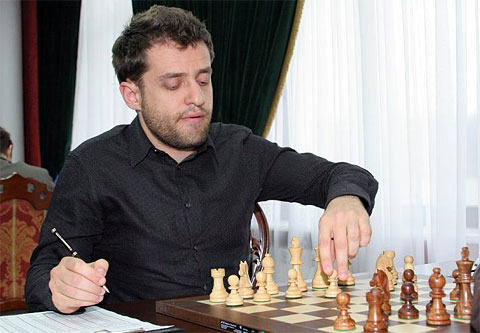 Levon Aronian {link:www.chessgames.com/perl/chessgame?gid=1556260|Alexei Shirov - Levon Aronian] 2nd Grand Slam Masters, Round 3 Bilbao, 8 September 2009 Spanish Grand Royal Game: Marshall Gambit 1.e4 e5 2.Nf3 Nc6 3.Bb5 a6 4.Ba4 Nf6 5.0-0 Be7 6.Re1 b5 7.Bb3 0-0 8.c3 d5
9.exd5 Nxd5 10.Nxe5 Nxe5 11.Rxe5 c6 12.d4 Bd6 13.Re1 Qh4 14.g3 Qh3 15.Be3
15...Bg4 16.Qd3 Rae8 17.Nd2 Qh5
18.a4 Re6 19.axb5 axb5 20.Nf1
20...Bf5 21.Qd2 Bh3!?
!""""""""# $ + + Tl+% $+ + +oOo% $ +oVt+ +% $+o+m+ +w% $ + P + +% $+bP B Pv% $ P Q P P% $R + RnK % /(((((((() WHITE: Alexei Shirov Position after 21...Bf5h3 22.Bd1
22...Qg6
23.Bf3 Qf5
24.Bh1 Rfe8 25.Re2!?
25...h5!
26.Qc2 Qg4
27.Ree1?!
27...h4!
28.Qd1
28...Qf5 29.Qf3?
!""""""""# $ + +t+l+% $+ + +oO % $ +oVt+ +% $+o+m+w+ % $ + P + O% $+ P BqPv% $ P + P P% $R + RnKb% /(((((((() WHITE: Alexei Shirov Position after 29.Qd1f3 29...Qg6! 0-1
|
| Printer Friendly | Permalink | | Top |
| Jack Rabbit
|
Sun Sep-13-09 12:17 PM Response to Reply #2 |
| 8. Karjakin - Grischuk, Round 3 |
|
Edited on Sun Sep-13-09 12:21 PM by Jack Rabbit
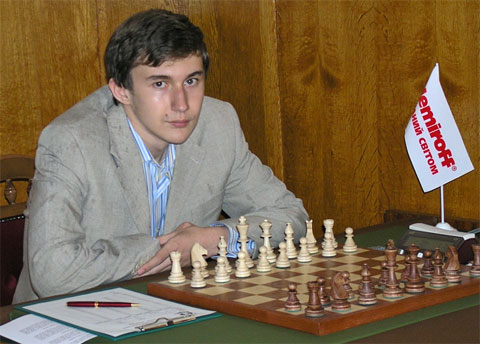 Sergey Karjakin Sergey Karjakin - Alexander Grischuk 2nd Grand Slam Masters, Round 3 Bilbao, 8 September 2009 Spanish Grand Royal Game: Zaitsev Defense 1.e4 e5 2.Nf3 Nc6 3.Bb5 a6 4.Ba4 Nf6 5.0-0 Be7 6.Re1 b5 7.Bb3 d6 8.c3 0-0 9.h3 Bb7 10.d4 Re8 11.Nbd2 Bf8 12.a3
12...h6
13.d5 Nb8 14.Nh2 Nbd7!? 15.Qf3 15...Qc8 16.Ndf1 c6 17.dxc6 17...Qxc6 18.Ng4 Re7!? !""""""""# $t+ + Vk+% $+v+mToO % $o+wO + O% $+o+ O + % $ + +p+n+% $PbP + +p% $ P + Pp+% $R B RnK % /(((((((() WHITE: Sergey Karjakin Position after 19...Re8e7 19.Ng3! 19...d5 20.exd5 Nxd5 21.Nf5! 21...Re6 22.Qg3 Kh8 23.Be3 23...h5 24.Rad1 Nxe3 25.Ngxe3 Rg6! 26.Qh2 Rf6?! 27.Bd5 Qc8 28.Qg3 28...g6 29.Qg5 Bg7?
30.Ne7! Qc7 31.Ng4 Rf4 32.Nh6 Rf8
!""""""""# $ + + T L% $+vWmNoV % $o+ + +oN% $+o+bO Qo% $ + + T +% $P P + +p% $ P + Pp+% $+ +rR K % /(((((((() WHITE: Sergey Karjakin Position after 32...Ra8f8 33.Nxf7+!!
33...R4xf7 34.Nxg6+ Kh7 35.Qxh5+
35...Bh6 36.Bxf7 Rxf7 37.Rxd7 Rxd7 38.Nf8+ Kg7 39.Ne6+ 1-0
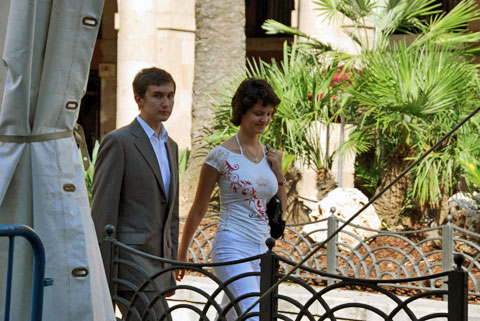 Sergey Karjakin walking to the tournament hall with Ukrainian WIM Katya Dolzhikova The couple were married in late July |
| Printer Friendly | Permalink | | Top |
| Jack Rabbit
|
Sun Sep-13-09 12:19 PM Response to Reply #2 |
| 9. Grischuk - Shirov, Round 2 |
 Alexander Grischuk Alexander Grischuk - Alexei Shirov 2nd Grand Slam Masters, Round 2 Bilbao, 7 September 2009 Semi-Slav Queen's Gambit: Meran Defense (Wade Variation) 1.d4 d5 2.Nf3 Nf6 3.c4 c6 4.Nc3 e6 5.e3 Nbd7 6.Bd3 dxc4 7.Bxc4 b5 8.Bd3
8...Bb7
9.e4 b4
10.Na4 c5 11.e5 Nd5 12.0-0
12...cxd4 13.Nxd4
13...Be7 14.Re1 0-0 15.Qg4 Re8 16.Bb5
16...Kh8 17.Bd2
17...a6 18.Bc6 Qc7!?
!""""""""# $t+ +t+ L% $+vWmVoOo% $o+b+o+ +% $+ +mP + % $nO N +q+% $+ + + + % $pP B PpP% $R + R K % /(((((((() WHITE: Alexander Grischuk Position after 18...Qd8c7 19.Rac1
19...Nxe5 20.Bxb7
20...Nxg4 21.Rxc7 Nxc7 22.Bxa8 Rxa8 23.Nc6 Nd5 24.Nxe7 Nxe7 25.Bxb4
25...Nd5 26.Bd2 Rc8 27.Rc1 Rxc1+ 28.Bxc1 Ne5 29.Nc5 Nb4
30.b3 Nxa2!?
!""""""""# $ + + + L% $+ + +oOo% $o+ +o+ +% $+ N M + % $ + + + +% $+p+ + + % $m+ + PpP% $+ B + K % /(((((((() WHITE: Alexander Grischuk Position after 30...Nb4a2:p 31.Bb2!
31...Nc6 32.Nxa6!
32...Kg8 33.Kf1 f6 34.Ke2 Nab4
35.Nxb4 Nxb4 36.Ke3 Kf7 37.Kd4 Nc2+ 38.Kc5 Ne1!?
39.Kc6!
39...Nxg2?
40.b4!
40...Nf4 41.b5 Nd5 42.Kd6
42...Kg6 43.Bd4 Kg5 !""""""""# $ + + + +% $+ + + Oo% $ + KoO +% $+p+m+ L % $ + B + +% $+ + + + % $ + + P P% $+ + + + % /(((((((() WHITE: Alexander Grischuk Position after 43...Kg6g5 44.b6!
44...Nxb6 45.Bxb6 e5 46.Ke6 e4 47.Kf7 f5 48.Kxg7 h5
49.Kf7 f4 50.Ke6 Kg4 51.Ke5 Kf3 52.h4! 1-0
!""""""""# $ + + + +% $+ + + + % $ B + + +% $+ + K +o% $ + +oO P% $+ + +l+ % $ + + P +% $+ + + + % /(((((((() WHITE: Alexander Grischuk Final Position after 52.h2h4
|
| Printer Friendly | Permalink | | Top |
| Jack Rabbit
|
Sun Sep-13-09 12:09 PM Response to Reply #1 |
| 3. Russian Champion Higher League, Ulan-Ude |
| Printer Friendly | Permalink | | Top |
| Jack Rabbit
|
Sun Sep-13-09 12:22 PM Response to Reply #3 |
| 10. Tomashevsky - Sjugirov, Round 6 |
 Evgeny Tomashevsky Evgeny Tomashevky - Sanan Sjugirov Russian Championship Higher League, Round 6 Ulan-Ude, 7 September 2009 English Game: Agincourt Defense 1.c4 e6 2.Nf3 d5 3.g3 dxc4 4.Bg2 Nd7 5.0-0
5...Ngf6 6.Qc2 a6 7.a4 Nc5!?
8.Na3
8...Nb3
9.Rb1 Bxa3 10.bxa3 b5
11.Bb2 Bb7 12.d3 0-0
13.axb5 axb5 14.dxc4 bxc4 15.Rbd1 Be4 16.Qxc4
16...Na5 17.Qb4 Bd5 18.Nh4!?
18...c5!
19.Qc3 Qb8?
!""""""""# $tW + Tl+% $+ + +oOO% $ + +oM +% $M Ov+ + % $ + + + N% $P Q + P % $ B + PbP% $+ +r+rK % /(((((((() WHITE: Evgeny Tomashevsky Position after 19...Qd8b8 20.Bxd5!
20...exd5 21.Rxd5 Nc4
22.Ba1 Rxa3
23.Qxc4 Nxd5 24.Qxd5 Qa8 25.Qd1 f6
!""""""""# $w+ + Tl+% $+ + + Oo% $ + + O +% $+ O + + % $ + + + N% $T + + P % $ + +pP P% $B +q+rK % /(((((((() WHITE: Evgeny Tomashevsky Position after 25...f7f6 26.Nf5!
26...c4
27.Qd4 Kh8 28.Bc3 Ra4 29.e4 Qc6 30.e5 Raa8 31.Qg4 1-0
|
| Printer Friendly | Permalink | | Top |
| Jack Rabbit
|
Sun Sep-13-09 12:24 PM Response to Reply #3 |
| 11. Borachov - Khrismatullin, Round 9 |
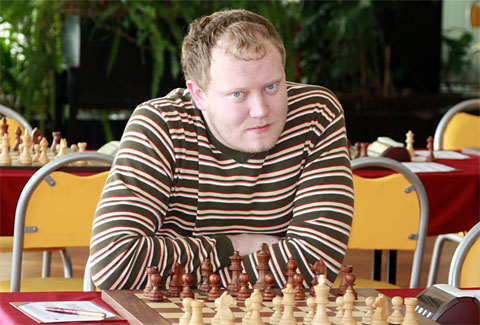 Denis Khrismatullin Dmitry Borachov - Denis Khrismatullin Russian Championship Higher League, Round 9 Ulan=Ude, 11 September 2009 East Indian Game: Nimzo-Indian Defense (Rubinstein Opening) 1.d4 Nf6 2.c4 e6 3.Nc3 Bb4 4.e3 0-0 5.Bd3
5...c5 6.Nge2
6...d5 7.cxd5
7...cxd4 8.exd4 Nxd5 9.0-0 Nc6 10.a3
10...Nxc3
11.bxc3 Bd6 12.c4
12...b6
13.Bb2 Bb7 14.Rc1 Rc8 15.f4
15...Na5 16.d5?
16...exd5 17.Ng3
!""""""""# $ +tW Tl+% $Ov+ +oOo% $ O V + +% $M +o+ + % $ +p+ P +% $P +b+ N % $ B + +pP% $+ Rq+rK % /(((((((() WHITE: Dmitry Borachov Position after 17.Ne2g3 17...Nxc4!
18.Bxg7
18...Bc5+ 19.Kh1 Ne3! 20.Qh5 Kxg7!
21.Qxh7+ Kf6 22.Qh6+ Ke7 23.Rfe1 d4! 24.Nf5+ Kd7 25.Rxc5
25...Bxg2+
26.Kg1 Rxc5 27.Rxe3
27...dxe3 28.Qd6+ Kc8 29.Ba6+ Bb7 30.Ne7+ Qxe7!! 0-1
!""""""""# $ +l+ T +% $Ov+ Wo+ % $bO Q + +% $+ T + + % $ + + P +% $P + O + % $ + + + P% $+ + + K % /(((((((() WHITE: Dmitry Borachov Final Position after 30...Qd8e7:N
|
| Printer Friendly | Permalink | | Top |
| Jack Rabbit
|
Sun Sep-13-09 12:26 PM Response to Reply #3 |
| 12. Nepomniachtchi - Zvjaginsev, Round 6 |
|
Edited on Sun Sep-13-09 12:42 PM by Jack Rabbit
 Vadim Zvjaginsev Ian Nepomniachtchi - Vadim Zvjaginsev Russian Championship Higher League, Round 8 Ulan=Ude, 10 September 2009 Open Sicilian Game: Taimanov Defense 1.e4 c5 2.Nf3 d6 3.d4 cxd4 4.Nxd4 Nf6 5.Nc3 Bd7 6.Bc4 e6 7.Qe2
7...Be7 8.Be3 a6 9.Bb3 b5
10.f3 0-0 11.g4!?
11...b4
12.Nd1 Nc6 13.Nf2 Nxd4 14.Bxd4 Bb5 15.Qd2 a5 16.c3 bxc3!?
17.Bxc3
17...Nd7
18.a4!?
18...Ba6 19.Bd1
19...Bf6?!
20.Bxa5!
20...Qe7 21.Rc1
21...Ne5
22.g5?
!""""""""# $t+ + Tl+% $+ + WoOo% $v+ OoV +% $B + M P % $o+ +p+ +% $+ + +p+ % $ P Q N P% $+ RbK +r% /(((((((() WHITE: Ian Nepomniachtci Position after 22.g4g5 22...Bxg5 23.f4 Bh6!
24.Qe3 Ng6 25.Rc7 Nxf4 26.Qg3
26...Qg5 27.Qxg5 Bxg5 28.Rg1 Bh4 29.Rg3
!""""""""# $t+t+ +l+% $+ R +oOo% $v+ Oo+ +% $B + + + % $p+ +pM V% $+ + + R % $ P + N P% $+ +bK + % /(((((((() WHITE: Ian Nepomniachtci Position after 29.Rg1g3 29...Rfc8!
30.Rxc8+ Rxc8 31.Kd2
31...Bxg3 32.hxg3 Ng6
33.Ng4
33...Bb7 34.Bc2 h5 35.Ne3 Ne5 36.Bc3 g5
37.Ke2
37...Kf8 38.Kf2 Ke7 39.a5 Ba6 40.Bd1
!""""""""# $ +t+ + +% $+ + Lo+ % $v+ Oo+ +% $P + M Oo% $ + +p+ +% $+ B N P % $ P + K +% $+ +b+ + % /(((((((() WHITE: Ian Nepomniachtci Position after 40.Bc2d1 40...h4!
41.gxh4 gxh4 42.Ng4
42...Nxg4+ 43.Bxg4 Rg8 44.Bh3 e5 45.Bd2
45...Bc8 46.Bg5+ f6 47.Bxc8 Rxc8 48.Bxh4 Rc2+ 0-1
|
| Printer Friendly | Permalink | | Top |
| Jack Rabbit
|
Sun Sep-13-09 12:10 PM Response to Reply #1 |
| 4. Fourth Kolkata Open |
| Printer Friendly | Permalink | | Top |
| Jack Rabbit
|
Sun Sep-13-09 12:29 PM Response to Reply #4 |
| 13. Le Quang Liem - Hossain, Round 6 |
 Le Quang Liem Le Quang Liem - Enamul Hossain 4th Open Tournament, Round 6 Kokata, 6 Spetember 2009 West India Game: King's Indian Defense 1.d4 Nf6 2.Nf3 g6 3.c4 Bg7 4.Nc3 0-0 5.e4 d6 6.Be2 e5 7.0-0 Nc6 8.d5 Ne7
9.Ne1
9...Ne8 10.f3
10...f5 11.g4
11...Kh8 12.Kh1
12...fxg4
13.fxg4 Rxf1+ 14.Bxf1 Ng8!?
15.g5
15...Bf8?!
!""""""""# $t+vWmVmL% $OoO + +o% $ + O +o+% $+ +pO P % $ +p+p+ +% $+ N + + % $pP + + P% $R BqNb+k% /(((((((() WHITE: Le Quang Liem Position after 15...Bg7f8 16.Qf3!
16...Ng7
17.Nd3 Be7 18.Qg2 Bd7
19.Be3 c5
20.dxc6
20...Bxc6 21.Nd5!
21...b6 22.h4 Qd7 23.Qh3 Qxh3+?
24.Bxh3 Nh5
25.Kg2 Rf8 26.a4
26...Bd8 27.Be6
27...Ne7 28.Bd2 Bb7!?
!""""""""# $ + V T L% $Ov+ M +p% $ O Ov+o+% $+ +nO Pm% $p+p+p+ P% $+ +n+ + % $ P B +k+% $R + + + % /(((((((() WHITE: Le Quang Liem Position after 28...Bc6b7 29.Bb4!
29...Nxd5
30.exd5 Be7 31.a5 Ng7 32.Bd7 b5 33.a6
33...Bc8 34.Bxc8 Rxc8 35.cxb5 Nf5
36.Rc1 Rf8
37.Rc7 Nxh4+ 38.Kh2 Bxg5 39.Bxd6 Rf3
!""""""""# $ + + + L% $O R + +o% $p+ B +o+% $+p+pP V % $ + + + M% $+ +n+t+ % $ P + + K% $+ + + + % /(((((((() WHITE: Le Quang Liem Position after 39...Rf8f3 40.b6!!
40...Rxd3 41.Bxe5+!
41...Kg8 42.bxa7 1-0
|
| Printer Friendly | Permalink | | Top |
| Jack Rabbit
|
Sun Sep-13-09 12:12 PM Response to Reply #1 |
| 5. Second Women's World Championship, Ningbo |
| Printer Friendly | Permalink | | Top |
| Jack Rabbit
|
Sun Sep-13-09 12:31 PM Response to Reply #5 |
| 14. T. Kosintseva - Hou Yifan, Round 5 |
 Still growing at fifteen: Hou Yifan Tatiana Kosintseva (Russia) - Hou Yifan (China) 2nd Women's World Team Championship, Round 5 Ningbo, 6 September 2009 Open Sicilian Game: Scheveningen Defense (Keres Opening) 1.e4 c5 2.Nf3 e6 3.d4 cxd4 4.Nxd4 Nc6 5.Nc3 d6 6.g4 Nge7
7.Be3 a6 8.Nb3 b5 9.a3
9...Ng6!?
10.Qe2
10...Nge5 11.Bg2 Bd7
12.Rd1 Be7 13.0-0 g5
14.Nd4 Nxd4 15.Bxd4 0-0 16.f4 gxf4
17.Rxf4 Bg5 18.Rff1 Qe7
19.Be3!?
!""""""""# $t+ + Tl+% $+ +vWo+o% $o+ Oo+ +% $+o+ N V % $ + +p+p+% $P N B + % $ Pp+w+bP% $+ +t+tK % /(((((((() WHITE: Tatiana Kosintseva Position after 19.Bd4e3 19...Nc4!
20.Bxg5 Qxg5 21.e5 d5 22.Rde1
22...Rac8! 23.Rf3 Nxb2 24.h4 Qxh4 25.Rh3 Qg5 26.Bxd5
!""""""""# $ +t+ Tl+% $+ +v+o+o% $o+ +o+ +% $+o+vP W % $ + + +p+% $P N + +r% $ Mp+q+ +% $+ + R K % /(((((((() WHITE: Tatiana Kosintseva Position after 26.Bg2d5:p 26...Rxc3!
27.Rxc3 exd5 28.Qg2 Nc4 29.Qxd5 Qxg4+ 30.Qg2
30...Qxg2+ 31.Kxg2 Re8 32.Rg3+ Kf8 33.Rg5 Re6 0-1
|
| Printer Friendly | Permalink | | Top |
| Jack Rabbit
|
Sun Sep-13-09 12:33 PM Response to Reply #5 |
| 15. Huang Qian - Majdan, Round 8 |
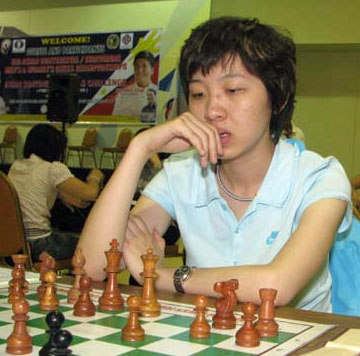 Huang Qian Huang Qian (China) - Joanna Majdan (Poland) 2nd Women's World Team Championship, Round 8 Ningbo, 10 September 2009 Benoni Game 1.d4 e6 2.c4 c5 3.d5 exd5 4.cxd5 d6 5.Nc3 g6 6.e4 Bg7 7.Nf3 a6 8.a4 Bg4 9.Be2 Bxf3
10.Bxf3 Nd7
11.0-0 Ne7 12.Be2!?
12...0-0 13.Bf4
13...Qc7 14.Qd2 f5 15.Rac1 Rae8 16.b4 c4!?
17.Rfe1!
17...Ne5 18.b5!?
18...Qa5 19.Bf1
19...fxe4?
!""""""""# $ + +tTl+% $+o+ M Vo% $o+ O +o+% $Wp+pM + % $p+o+oB +% $+ N + + % $ + Q PpP% $+ R RvK % /(((((((() WHITE: Huang Qian Position after 19...fe4:p 20.Nxe4!
20...Qxd2 21.Bxd2 axb5 22.Nxd6
22...Rd8 23.Bg5 Rd7
24.Bxe7 Rxe7 25.Nxb5 Ref7
26.f3 Rf4 27.Red1 Bf6
!""""""""# $ + + Tl+% $+o+ + +o% $ + + Vo+% $+n+pM + % $p+o+ T +% $+ + +p+ % $ + + +pP% $+ Rr+bK % /(((((((() WHITE: Huang Qian Position after 27...Bg7f6 28.Nc7!
28...Rc8 29.Ne6 Rf5 30.d6
30...Kf7 31.Nc7 Rf4 32.Nd5 Rh4 33.f4 Ng4
34.Rxc4 Rd8 35.h3 Nh6 36.g3 1-0
|
| Printer Friendly | Permalink | | Top |
| Jack Rabbit
|
Sun Sep-13-09 12:34 PM Response to Reply #5 |
| 16. Mkrtchian - Zawadaka, Round 6 |
 Lilit Mkrtchian Lilit Mkrtchian (Armenia) - Jolanta Zawadzka (Poland) 2nd Women's World Team Championship, Round 6 Ningbo, 7 September 2009 Semi-Slav Queen's Gambit 1.d4 d5 2.c4 e6 3.Nf3 c6 4.e3 Nf6 5.b3
5...Bb4+
6.Nbd2 c5
7.Bb2 cxd4 8.exd4 0-0
9.Bd3 b6!?
10.a3
10...Be7 11.0-0 Bb7 12.Qe2 Nc6 13.Rac1 Rc8
14.Rfd1 Re8 15.Qe3 Nd7!?
!""""""""# $ +tWt+l+% $Ov+mVoOo% $ Om+o+ +% $+ +o+ + % $ +pP + +% $Pp+bQn+ % $ B N PpP% $+ Rr+ K % /(((((((() WHITE: Lilit Mkrtchian Position after 15...Nf6d7 16.cxd5
16...exd5 17.Ne5 Nf8 18.Qh3
18...Bg5 19.Rc2 Bf6
20.Ndf3 Na5 21.Nd7
21...h6 22.Nxf8!?
22...Kxf8
23.Ne5 Rxc2?!
24.Bxc2!
24...Bc8 25.Qd3 Qd6
26.a4
26...Nc6 27.f4
27...Ne7?
!""""""""# $ +v+tL +% $O + MoO % $ O W V O% $+ +oN + % $p+ P P +% $+p+q+ + % $ Bb+ +oO% $+ +r+ K % /(((((((() WHITE: Lilit Mkrtchian Position after 27...Nc6e7 28.Qh7!
28...Ng8 29.Nxf7 Qxf4
30.Ba3+ Be7 31.Bxe7+ Rxe7 32.Ne5 Qe3+
33.Kh1 Re6
34.Bf5 Rf6 35.Bxc8 Qxd4
36.Nd7+ Kf7 37.Qb1 1-0
|
| Printer Friendly | Permalink | | Top |
| Jack Rabbit
|
Sun Sep-13-09 12:36 PM Response to Reply #5 |
| 17. Huang Qian - Melekhina, Round 6 |
 Alisa Melekhina Huang Qian (China) - Alisa Melekhina (United States) 2nd Women's World Team Championship, Round 6 Ningbo, 7 September 2009 Indian Game: Trompowsky Opening 1.d4 Nf6 2.Bg5 g6
3.Bxf6 exf6 4.e3 f5 5.Ne2 Bg7 6.g3
6...d6 7.Bg2 0-0 8.0-0 Nd7 9.c4 Nf6 10.Nbc3 h5
11.h4!?
11...Ng4
12.Nf4 g5?
!""""""""# $ + +t+l+% $Oo+ +oW % $ +oOtV +% $+ + +o+ % $ +pP Qm+% $+ NrP Pn% $pP + +b+% $+ + R K % /(((((((() WHITE: Huang Qian Position after 12...g6g5 13.hxg5!
13...Qxg5 14.Qf3 c6 15.Rfe1 Re8 16.Rad1 h4 17.Nce2
17...Bf6
18.Nh3 Qg7 19.Qf4 Re6 20.Nc3 hxg3 21.fxg3!?
21...Bd7!
22.Rd3
22...Rae8
!""""""""# $ + +t+l+% $Oo+v+oW % $ +oOtV +% $+ + +o+ % $ +pP Qm+% $+ NrP Pn% $pP + +v+% $+ + R K % /(((((((() WHITE: Huang Qian Position after 22...Ra8e8 23.Nd1
23...Bc8 24.Re2 c5 25.Bd5!?
25...R6e7!
26.dxc5 dxc5 27.Qf3?
!""""""""# $ +v+t+l+% $Oo+ ToW % $ + + B +% $+ Ob+o+ % $ +p+ +m+% $+ +rPqPn% $pP +r+ +% $+ +n+ K % /(((((((() WHITE: Huang Qian Position after 27.Qf4f3 27...Ne5! 0-1
|
| Printer Friendly | Permalink | | Top |
| Jack Rabbit
|
Sun Sep-13-09 12:13 PM Response to Reply #1 |
| 6. !06h Empresa International Tournament, Montreal |
| Printer Friendly | Permalink | | Top |
| Jack Rabbit
|
Sun Sep-13-09 12:38 PM Response to Reply #6 |
| 18. Naiditsch - Bhat, Round 11 |
 Arkadij Naiditsch Arkadij Naiditsch - Vinay Bhat Empresa International Chess Tournament, Round 11 Montreal, 7 September 2009 German Exchange Game: Accelerated Panov Opening (Caro-Kann Defense) 1.c4 c6 2.e4 d5 3.exd5
3...cxd5 4.d4 Nf6 5.Nc3 g6 6.Qb3
6...Bg7 7.cxd5 0-0 8.Nge2
8...Re8
9.Nf4
9...Nbd7!?
10.Be2
10...Nb6
11.0-0 h6 12.a4 a5 13.h4!?
13...Bf5 14.Be3 Qd6 15.Nb5!
15...Qd8 16.Rac1 Nfxd5 17.Bf3
17...Nxe3
18.fxe3 e5!?
!""""""""# $t+ Wt+l+% $+o+ +oV % $ M + +oO% $On+ Ov+ % $p+ P N P% $+q+ Pb+ % $ P + +p+% $+ R +rK % /(((((((() WHITE: Arkadij Naiditsch Position after 18...e7e5 19.dxe5!
19...Bxe5 20.h5!?
20...Kg7?
21.Bxb7!
21...Rb8 22.Bc6 Rf8
23.hxg6 fxg6
24.Be4 Qh4 25.Bxf5 Rxf5
!""""""""# $ T + + +% $+ + + L % $ M + +oO% $On+ Vt+ % $p+ + N W% $+q+ P + % $ P + +p+% $+ R +rK % /(((((((() WHITE: Arkadij Naiditsch Position after 25...Rf8f5:B 26.Nd4!
26...Rh5
27.Nf3 1-0
|
| Printer Friendly | Permalink | | Top |
| Jack Rabbit
|
Sun Sep-13-09 06:53 PM Response to Original message |
| 19. My hero . . . |
|
Please click here and watch the video.
|
| Printer Friendly | Permalink | | Top |
| DU
AdBot (1000+ posts) |
Fri Apr 26th 2024, 08:55 PM Response to Original message |
| Advertisements [?] |
| Top |
| Home » Discuss » Topic Forums » Sports |
|
Powered by DCForum+ Version 1.1 Copyright 1997-2002 DCScripts.com
Software has been extensively modified by the DU administrators
Important Notices: By participating on this discussion board, visitors agree to abide by the rules outlined on our Rules page. Messages posted on the Democratic Underground Discussion Forums are the opinions of the individuals who post them, and do not necessarily represent the opinions of Democratic Underground, LLC.
Home | Discussion Forums | Journals | Store | Donate
About DU | Contact Us | Privacy Policy
Got a message for Democratic Underground? Click here to send us a message.
© 2001 - 2011 Democratic Underground, LLC